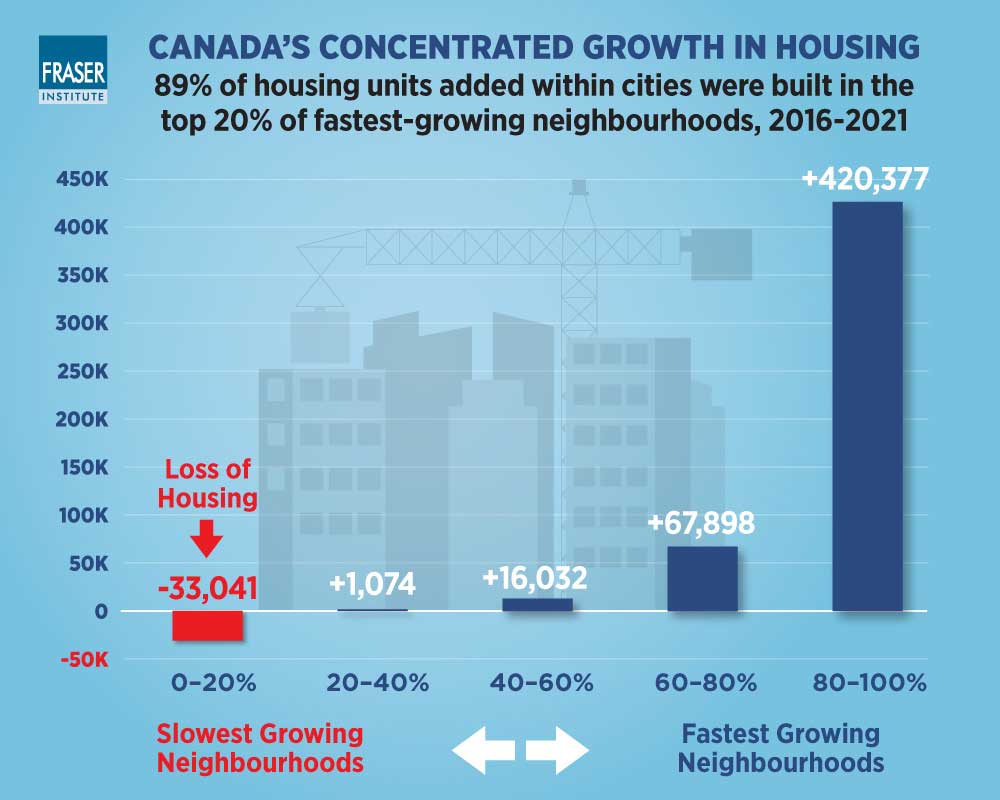Study
| EST. READ TIME 1 MIN.Despite housing shortage, 1-in-4 neighbourhoods in Canadian cities saw number of housing units actually decline from 2016-2021
Making Room for Growth: Housing Intensification in Canada’s Cities, 2016-2021
Main Conclusions
- As Canada struggles to close the gap between the number of homes needed and the number built, its communities are faced with two options to increase housing supply: spreading outward, by adding new neighbourhoods at the urban fringe, or becoming more dense, by allowing more homes to be built within existing neighbourhoods—a process called “intensification”.
- A majority (54.2%) of the growth in Canada’s housing stock between 2016 and 2021 occurred in existing neighbourhoods, rather than on undeveloped land; intensification is a major driver of growth in Canada’s housing stock.
- A little more than half of this intensification (50.9%) occurred in the fastest-growing 5% of urban census tracts, suggesting a highly uneven pattern of growth in the housing stock.
- On the other hand, more than a quarter (26.4%) of urban tracts lost more dwellings over this period than they added, representing a cumulative net loss of 33,723 dwellings.
- This highly uneven growth pattern holds across most major metropolitan areas.
- Canada faces an acute shortage of housing, and needs to increase housing supply across all housing types, regions, and neighbourhoods.
- Given the important role played by intensification in accommodating a fast-growing population, the trends identified in this report should inform urban policy makers and Canadians in search of adequate housing options.

Share
-

Josef Filipowicz
Senior Fellow (On Leave)
Josef Filipowicz, Senior Fellow of the Fraser Institute, is an independent urban and regional policy specialist, and former analyst at theCanada Mortgage and Housing Corporation and the Fraser Institute’s Centre for Municipal Studies. He holds an M.A. in Political Science from Wilfrid Laurier University and a Bachelor of Urban and Regional Planning from Ryerson University. He conducts research and produces reports on land-use regulations, housing affordability, property taxation, and municipal finance. He also comments frequently (in English and French) on policy issues in these fields, notably through radio and television interviews, panel discussions, public presentations, and blogs and op-eds. His work has been featured in numerous news outlets including the Wall Street Journal, Globe and Mail, Toronto Star, Maclean’s, Detroit News, and Financial Post.… Read more Read Less… -

Steve Lafleur
Steve Lafleur is a research director at the Institute for Research on Public Policy, a former senior fellow of theFraser Institute and a former senior policy analyst at the Fraser Institute. He holds an M.A. in Political Science from Wilfrid Laurier University and a B.A. from Laurentian University where he studied Political Science and Economics. He was previously a Senior Policy Analyst with the Frontier Centre for Public Policy in Winnipeg and is a Contributing Editor to New Geography. His past work has focused primarily on housing, transportation, local government and inter-governmental fiscal relations. His current focus is on economic competitiveness of jurisdictions in the Prairie provinces. His writing has appeared in every major national and regional Canadian newspaper and his work has been cited by many sources including the Partnership for a New American Economy and the Reason Foundation.… Read more Read Less…
Related Topics
Related Articles
Policymakers must make Canada more attractive to investors—not just homebuyers
By: Steven Globerman
Is Ontario too Toronto-centric?
By: Livio Di Matteo
Federal government’s turbo-charged immigration helping drive housing demand
By: Jock Finlayson
Ottawa’s homebuilding plans might discourage much-needed business investment
By: Steven Globerman